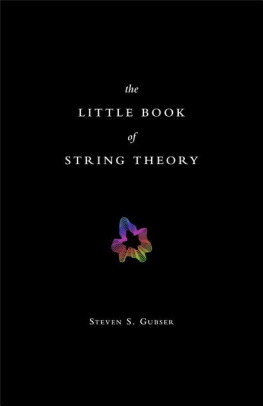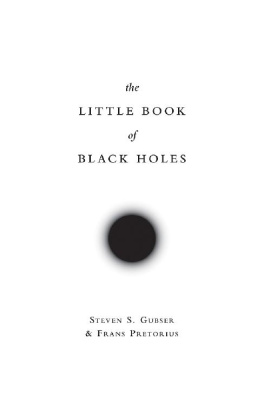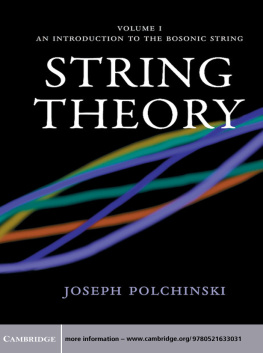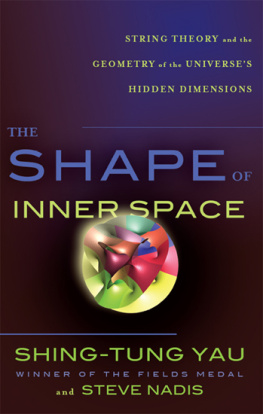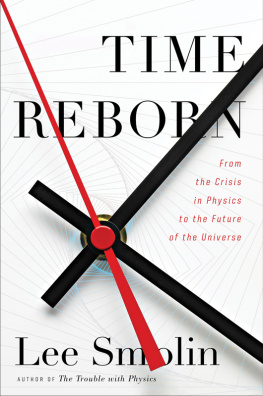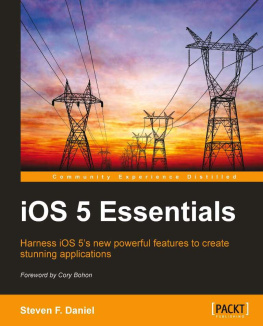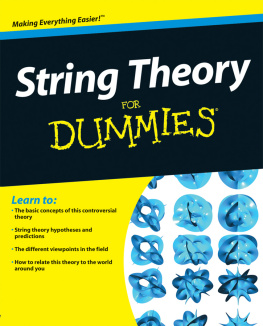Steven S. Gubser - The Little Book of String Theory (Science Essentials)
Here you can read online Steven S. Gubser - The Little Book of String Theory (Science Essentials) full text of the book (entire story) in english for free. Download pdf and epub, get meaning, cover and reviews about this ebook. year: 2010, publisher: Princeton University Press, genre: Art. Description of the work, (preface) as well as reviews are available. Best literature library LitArk.com created for fans of good reading and offers a wide selection of genres:
Romance novel
Science fiction
Adventure
Detective
Science
History
Home and family
Prose
Art
Politics
Computer
Non-fiction
Religion
Business
Children
Humor
Choose a favorite category and find really read worthwhile books. Enjoy immersion in the world of imagination, feel the emotions of the characters or learn something new for yourself, make an fascinating discovery.
- Book:The Little Book of String Theory (Science Essentials)
- Author:
- Publisher:Princeton University Press
- Genre:
- Year:2010
- Rating:4 / 5
- Favourites:Add to favourites
- Your mark:
- 80
- 1
- 2
- 3
- 4
- 5
The Little Book of String Theory (Science Essentials): summary, description and annotation
We offer to read an annotation, description, summary or preface (depends on what the author of the book "The Little Book of String Theory (Science Essentials)" wrote himself). If you haven't found the necessary information about the book — write in the comments, we will try to find it.
The Little Book of String Theory (Science Essentials) — read online for free the complete book (whole text) full work
Below is the text of the book, divided by pages. System saving the place of the last page read, allows you to conveniently read the book "The Little Book of String Theory (Science Essentials)" online for free, without having to search again every time where you left off. Put a bookmark, and you can go to the page where you finished reading at any time.
Font size:
Interval:
Bookmark:

THE LITTLE BOOK OF STRING THEORY
Books in the SCIENCE ESSENTIALS series bring cutting-edge science to a general audience. The series provides the foundation for a better understanding of the scientific and technical advances changing our world. In each volume, a prominent scientistchosen by an advisory board of National Academy of Science membersconveys in clear prose the fundamental knowledge underlying a rapidly evolving field of scientific endeavor.
The Great Brain Debate: Nature or Nurture,
by John Dowling
Memory: The Key to Consciousness,
by Richard F. Thompson and Stephen Madigan
The Faces of Terrorism: Social and Psychological Dimensions,
by Neil J. Smelser
The Mystery of the Missing Antimatter,
by Helen R. Quinn and Yossi Nir
The Long Thaw: How Humans Are Changing the Next 100,000 Years of Earths Climate,
by David Archer
The Medea Hypothesis: Is Life on Earth Ultimately Self-Destructive?
by Peter Ward
How to Find a Habitable Planet,
by James Kasting
The Little Book of String Theory,
by Steven S. Gubser
LITTLE BOOK
of
STRING THEORY

S TEVEN S. G UBSER
PRINCETON UNIVERSITY PRESS PRINCETON AND OXFORD
Copyright 2010 by Steven S. Gubser
Requests for permission to reproduce material from this work
should be sent to Permissions, Princeton University Press
Published by Princeton University Press,
41 William Street, Princeton, New Jersey 08540
In the United Kingdom: Princeton University Press,
6 Oxford Street, Woodstock, Oxfordshire OX20 1TW
All Rights Reserved
Library of Congress Cataloging-in-Publication Data
Gubser, Steven Scott, 1972
The little book of string theory / Steven S. Gubser.
p. cm.(Science essentials)
Includes index.
ISBN 978-0-691-14289-0 (cloth : alk. paper)
1. String modelsPopular works. I. Title.
QC794.6.S85G83 2010
539.7258dc22
2009022871
British Library Cataloging-in-Publication Data is available
This book has been composed in Bembo
Printed on acid-free paper.
press.princeton.edu
Printed in the United States of America
10 9 8 7 6 5 4 3 2 1
To my father
S TRING THEORY IS A MYSTERY . I TS SUPPOSED TO BE THE THE ory of everything. But it hasnt been verified experimentally. And its so esoteric. Its all about extra dimensions, quantum fluctuations, and black holes. How can that be the world? Why cant everything be simpler?
String theory is a mystery. Its practitioners (of which I am one) admit they dont understand the theory. But calculation after calculation yields unexpectedly beautiful, connected results. One gets a sense of inevitability from studying string theory. How can this not be the world? How can such deep truths fail to connect to reality?
String theory is a mystery. It draws many talented graduate students away from other fascinating topics, like superconductivity, that already have industrial applications. It attracts media attention like few other fields in science. And it has vociferous detractors who deplore the spread of its influence and dismiss its achievements as unrelated to empirical science.
Briefly, the claim of string theory is that the fundamental objects that make up all matter are not particles, but strings. Strings are like little rubber bands, but very thin and very strong. An electron is supposed to be actually a string, vibrating and rotating on a length scale too small for us to probe even with the most advanced particle accelerators to date. In some versions of string theory, an electron is a closed loop of string. In others, it is a segment of string, with two endpoints.
Lets take a brief tour of the historical development of string theory.
String theory is sometimes described as a theory that was invented backwards. Backwards means that people had pieces of it quite well worked out without understanding the deep meaning of their results. First, in 1968, came a beautiful formula describing how strings bounce off one another. The formula was proposed before anyone realized that strings had anything to do with it. Math is funny that way. Formulas can sometimes be manipulated, checked, and extended without being deeply understood. Deep understanding did follow in this case, though, including the insight that string theory included gravity as described by the theory of general relativity.
In the 1970s and early 80s, string theory teetered on the brink of oblivion. It didnt seem to work for its original purpose, which was the description of nuclear forces. While it incorporated quantum mechanics, it seemed likely to have a subtle inconsistency called an anomaly. An example of an anomaly is that if there were particles similar to neutrinos, but electrically charged, then certain types of gravitational fields could spontaneously create electric charge. Thats bad because quantum mechanics needs the universe to maintain a strict balance between negative charges, like electrons, and positive charges, like protons. So it was a big relief when, in 1984, it was shown that string theory was free of anomalies. It was then perceived as a viable candidate to describe the universe.
This apparently technical result started the first super-string revolution: a period of frantic activity and dramatic advances, which nevertheless fell short of its stated goal, to produce a theory of everything. I was a kid when it got going, and I lived close to the Aspen Center for Physics, a hotbed of activity. I remember people muttering about whether super-string theory might be tested at the Superconducting Super Collider, and I wondered what was so super about it all. Well, superstrings are strings with the special property of supersymmetry. And what might supersymmetry be? Ill try to tell you more clearly later in this book, but for now, lets settle for two very partial statements. First: Supersymmetry relates particles with different spins. The spin of a particle is like the spin of a top, but unlike a top, a particle can never stop spinning. Second: Supersymmetric string theories are the string theories that we understand the best. Whereas non-supersymmetric string theories require 26 dimensions, supersymmetric ones only require ten. Naturally, one has to admit that even ten dimensions is six too many, because we perceive only three of space and one of time. Part of making string theory into a theory of the real world is somehow getting rid of those extra dimensions, or finding some useful role for them.
For the rest of the 1980s, string theorists raced furiously to uncover the theory of everything. But they didnt understand enough about string theory. It turns out that strings are not the whole story. The theory also requires the existence of branes: objects that extend in several dimensions. The simplest brane is a membrane. Like the surface of a drum, a membrane extends in two spatial dimensions. It is a surface that can vibrate. There are also 3-branes, which can fill the three dimensions of space that we experience and vibrate in the additional dimensions that string theory requires. There can also be 4-branes, 5-branes, and so on up to 9-branes. All of this starts to sound like a lot to swallow, but there are solid reasons to believe that you cant make sense of string theory without all these branes included. Some of these reasons have to do with string dualities. A duality is a relation between two apparently different objects, or two apparently different viewpoints. A simplistic example is a checkerboard. One view is that its a red board with black squares. Another view is that its a black board with red squares. Both viewpoints (made suitably precise) provide an adequate description of what a checkerboard looks like. Theyre different, but related under the interchange of red and black.
Font size:
Interval:
Bookmark:
Similar books «The Little Book of String Theory (Science Essentials)»
Look at similar books to The Little Book of String Theory (Science Essentials). We have selected literature similar in name and meaning in the hope of providing readers with more options to find new, interesting, not yet read works.
Discussion, reviews of the book The Little Book of String Theory (Science Essentials) and just readers' own opinions. Leave your comments, write what you think about the work, its meaning or the main characters. Specify what exactly you liked and what you didn't like, and why you think so.

